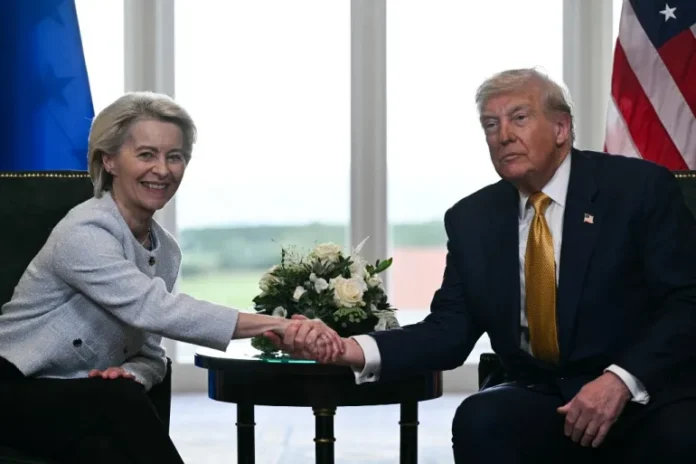The United States and the European Union reached a trade agreement on Sunday that imposes a 15% import tariff on most EU goods, avoiding a wider trade conflict between two of the world’s largest economies.
The rate is half of what was previously threatened.
The announcement came after a meeting between U.S. President Donald Trump and European Commission President Ursula von der Leyen at Trump’s golf course in Scotland. The two met for about an hour before confirming the agreement, which follows months of talks.
Trump said the deal includes EU plans to invest around $600 billion in the U.S. and increase purchases of American energy and military equipment. He called it the largest agreement ever made and said it would improve trade ties with the EU after what he described as years of unfair treatment of U.S. exporters.
The agreement follows a $550 billion trade deal signed between the U.S. and Japan last week.
Von der Leyen called Trump a tough negotiator and said the 15% tariff applies across the board. She described the agreement as the best outcome the EU could achieve, adding that it would help bring stability and predictability to trade relations.
The deal covers most goods, including semiconductors and pharmaceuticals, but there are exceptions. There will be no tariffs on aircraft and aircraft parts, certain chemicals, some agricultural goods, natural resources, generic medicines, and semiconductor equipment.
Tariffs on spirits remain under discussion.
The U.S. will continue to apply a 50% tariff on steel and aluminium imports. Von der Leyen said this could be replaced by a quota system. Talks on this and other remaining issues will continue, officials said.
The deal also includes a commitment by the EU to lower non-tariff barriers for U.S. automobiles and agricultural products, though discussions on specific standards are still ongoing.
According to Trump, the EU has agreed to purchase $750 billion worth of American energy over the coming years and large amounts of military equipment. The agreement may benefit companies like Airbus, Mercedes-Benz, and Novo Nordisk, depending on how the details are implemented.
Trump retains the right to raise tariffs if the EU does not meet its investment commitments. The U.S. administration said a review will be conducted before a final decision is made on the tariff rate for commercial aircraft, which remains at zero for now.
German Chancellor Friedrich Merz welcomed the deal, saying it avoided a trade dispute that could have affected Germany’s economy and car industry. European carmakers have been impacted by the current 27.5% U.S. tariff on cars and parts.
The 15% baseline tariff is still higher than what the EU had hoped for, as it initially aimed for a deal with no tariffs. Bernd Lange, head of the European Parliament’s trade committee, said the tariffs are unbalanced and that the EU’s planned investments in the U.S. could come at a cost to its own economy.
Trump has long criticized the U.S. trade deficit with the EU, which reached $235 billion in 2024. He has said tariffs bring in revenue for the U.S. and has dismissed concerns about inflation. On July 12, he had threatened a 30% tariff on EU imports starting August 1 if a deal could not be reached.
In response, the EU had prepared countertariffs on 93 billion euros worth of U.S. goods. The agreement reached Sunday prevents that outcome. Within an hour of the deal’s announcement, the euro rose about 0.2% against the dollar, the British pound, and the yen.




